By Lambert Strether of Corrente.
Thomas Frank’s The Wrecking Crew was published in 2008. It covers the ideology and praxis of post-Powell Memo conservatism, with particular attention to Bush the Younger — the “maladministration,” we used to call it — ending at the beginning of the Obama Era. Since I got on the Frank train only with 2016’s Listen, Liberal!, I hadn’t read it until I got the bright idea of writing this post.
Reviews back in the day were favorable but didn’t add a lot of value to the book itself, of which you are about to see several pages. Two caught my eye. The first is from an interview of Frank by the great Bill Moyers on PBS. In it, Frank puts the thesis of Wrecking Crew on a postcard:
You require several pages — riveting pages, I will admit — to describe a “fantastic misgovernment.” Distill the essence of it for a bumper sticker or t-shirt.
[FRANK:] .
Or: Cynicism spawns corruption, which spawns cynicism.
Or: Bring back the regulators before the system self-destructs.
(Moyers’ “riveting” is fair, not to say “coruscating” and “corrosive”; Frank gets really ticked off about all the right things, but never loses control of his register.) But were matters in 2008 really as bad as Frank says? Michael Lind sounds a cautionary note:
Missing from “The Wrecking Crew” is any acknowledgment of what, from a left perspective, should be considered good news: the defeat of the antigovernment right in most major policy battles, from Social Security privatization to private school vouchers. Bush’s plan for Social Security was so unpopular it never came to a vote in the Republican Congress, which enacted (to be sure, with payoffs to pharmaceutical companies) the Medicare prescription drug benefit, the biggest increase in government involvement in the health care industry in the United States since Medicare’s creation. Incapable of overthrowing big government, even when they controlled all three branches, the right has been limited to tinkering with it.
Indeed, one might argue that the defeat of the attempted libertarian revolution puts the money-making schemes of Frank’s villains in a different light. Former young conservative firebrands…. settled for enriching themselves precisely because they were unable to repeal the New Deal.
Note the sting in the tail:
But “The Wrecking Crew” is a polemic, not a dissertation.
A false dichotomy. Frank has a doctorate in history from the University of Chicago, and Wrecking Crew is a fine example of the historian’s craft, albeit directed to a popular audience. But as for Lind’s “good news,” “There is a great deal of ruin in a nation,” as Adam Smith remarked, and every single institution listed by Lind has gradually withered under conservative assault.
“Review” in the headline is a bit of a misnomer. Frank is writing a history of the period, but my purpose here is not to assess his thesis or tweak his timeline. Rather, I’m going to present a series of extracts from Wrecking Crew — with the most salient parts highlighted, as is my wont — and then compare them to current events in the Trump 2.0 administration. I think you will mind much that is very familiar! My purpose is to show, as the headline says, that “we’ve been here before.”
The epigraph, page vi:
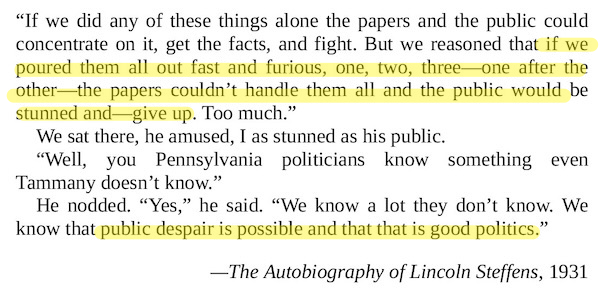
Sound familiar? This is Trump’s Gish Gallop — the rollout of the not-exactly-100 Executive Orders on the first day, for example, but in 1933. And the sense of “public despair” it is designed to engender.
Page 93:
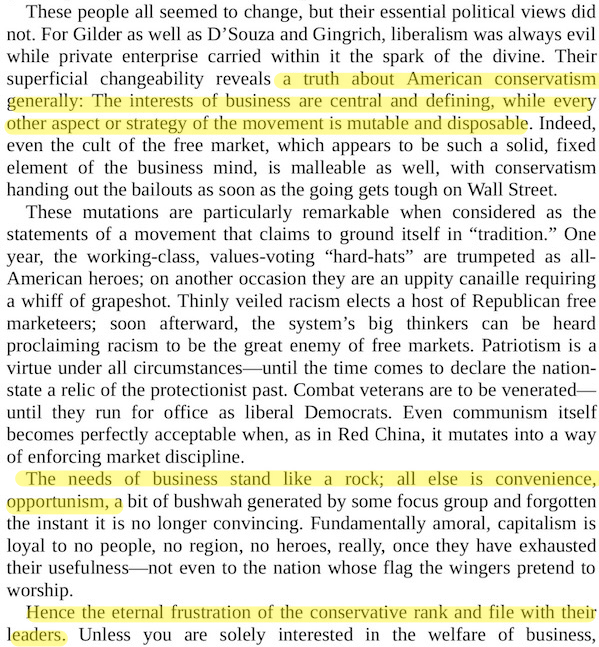
Little to quarrel with here, and DOGE throwing MAGA under the bus over H1B in the first days of the Trump administration is a perfect example. (How the MAGA base, which IMNSHO is much more aware and self-aware than liberal Democrats suppose, reacts to “eternal frustration” is, at this point, an open question.)
Page 41:
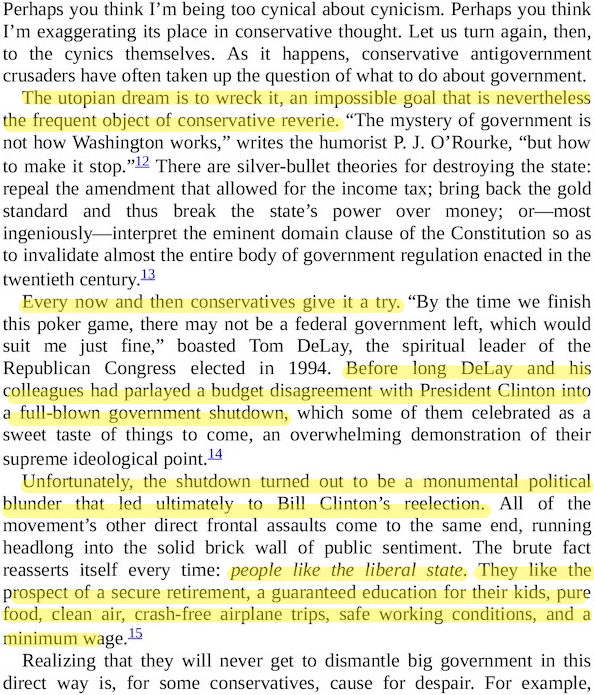
Clearly DOGE is a “wrecking crew” operation (though carried out with more competence and panache than conservatives in DeLay’s Day possesses). However, we might remind outselves that the “Contract with America” Republicans appeared just as invincible as MAGA and DOGE do today, but blundered into an (ideologically-driven) government shutdown. (I’m not praising Clinton, here; just saying a few months is a long time in politics.)
Page 66. Below, Frank labels conservative self-perception as “outsiders” “the adversarial fantasy”:
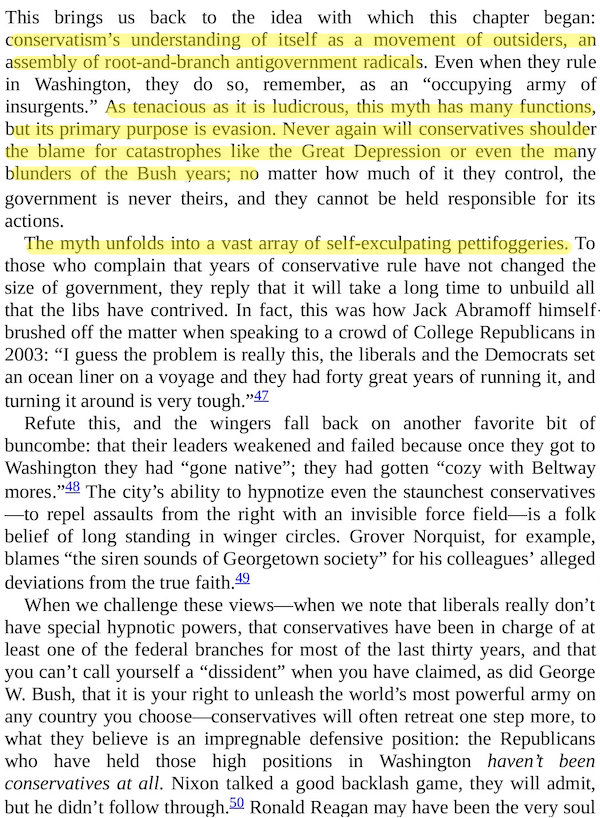
You have only to read X posts from Trump and DOGE supporters to see that what was true then is true now. I mean, in what sense — well, I can think of several, but you know what I mean — billionaire Peter Thiel an “outsider”? And so on down the line, to local gentry like auto dealerships.
Page 70. In addition to “the adversarial fantasy” we have conservatism is a money-making machine:
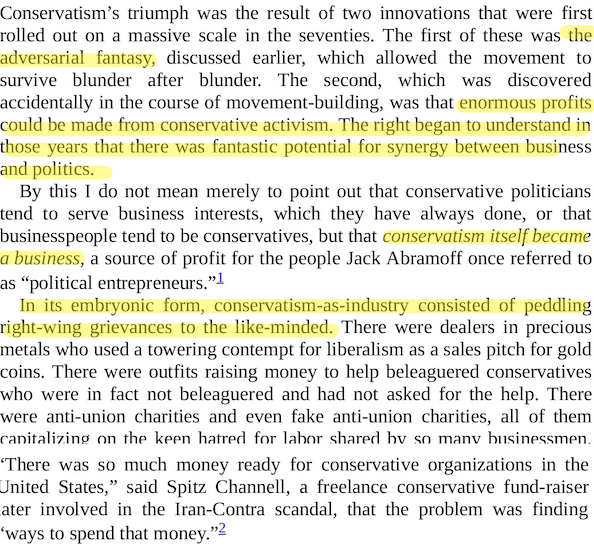
Today, “conservatism-as-industry,” besides the usual entities, takes the gargantuan form of Elon Musk’s X, where Mush simultaneously acts his part as Co-President, orders civil servants about (both traffic builders), and markets his various businesses (sometimes going to far as to intervene in public policy issues that directly benefit them, e.g. Starlink but also SpaceX as a brand).
Page 115, “personnel is policy”:
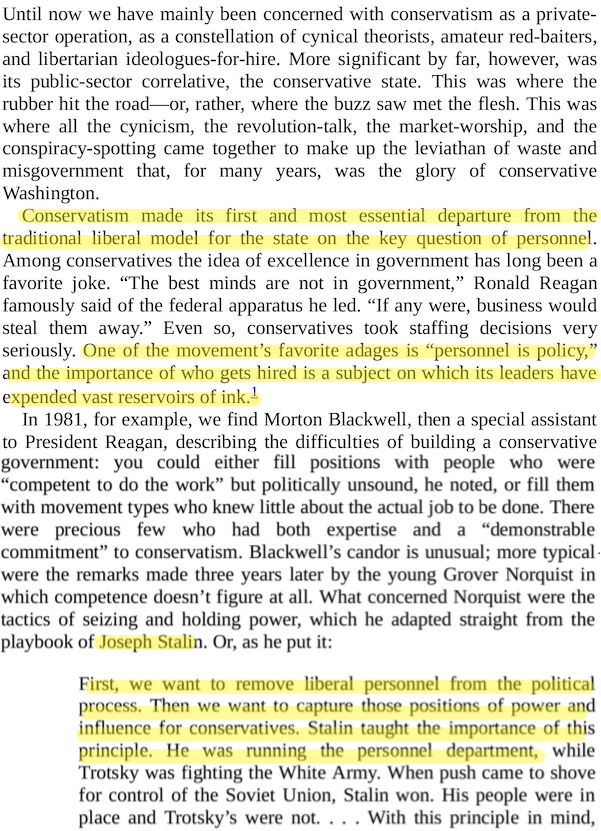
Musk explicitly urged that one effect of the “fork in the road” email would be to get workers out of government into the more productive private sector, the same argument that Reagan and Blackwell make. And DOGE, by seizing control of the Office of Personnel Management, and setting up a party structure that parallels the government, adopts the Leninist paradigm that Stalin exploited, as advocated by Blackwell.
Page 117, reinforcing the points above:
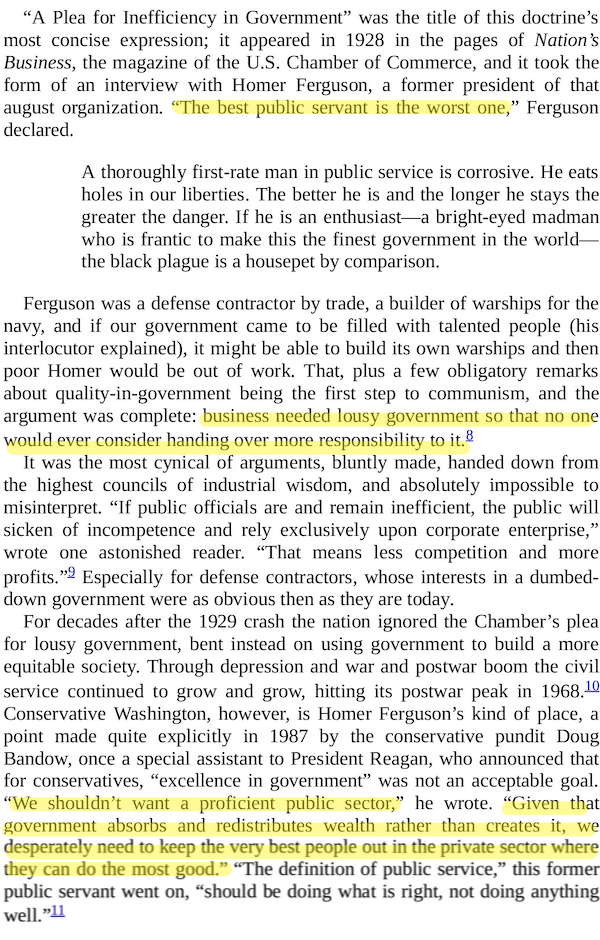
Page 138:
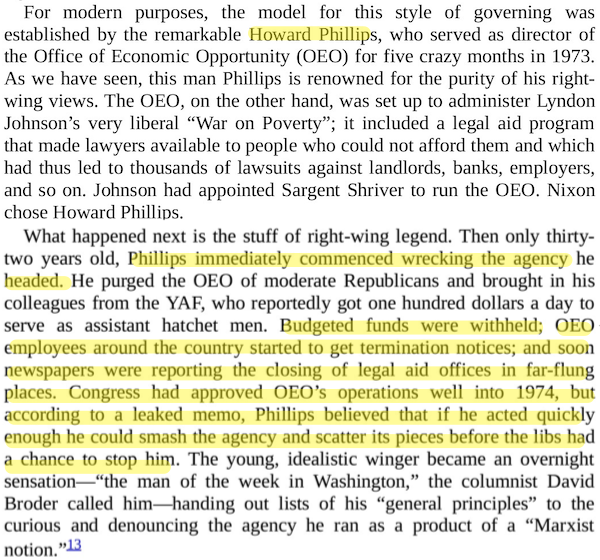
OEO = USAID, and whatever else DOGE gets its hands on (though so far Defense and the spooks have been exempt).
Page 221:
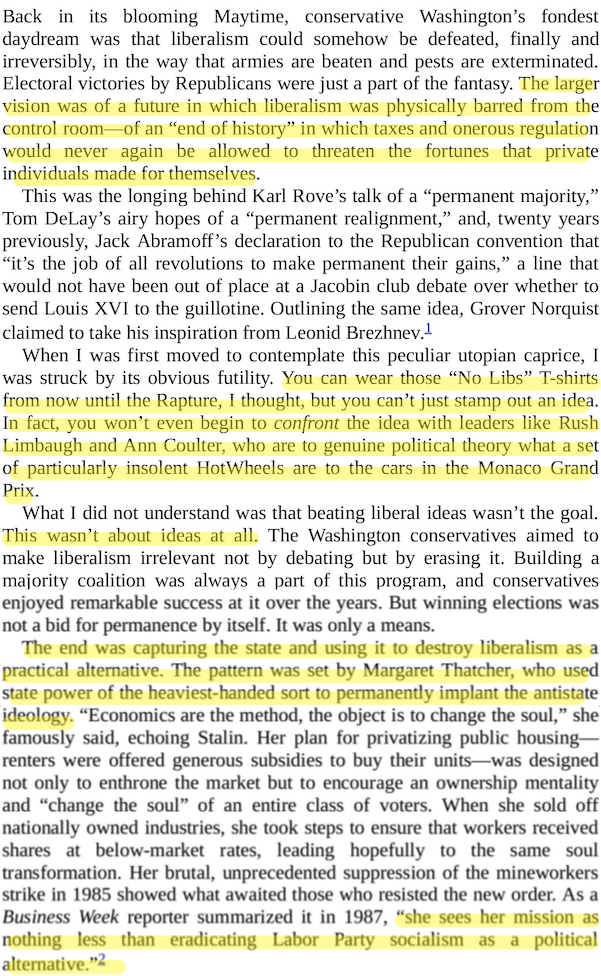
“The end was capturing the state and using it to destroy liberalism is a practical alternative” seems to sum up Trump’s Executive Orders in one sentence.
Page 223:
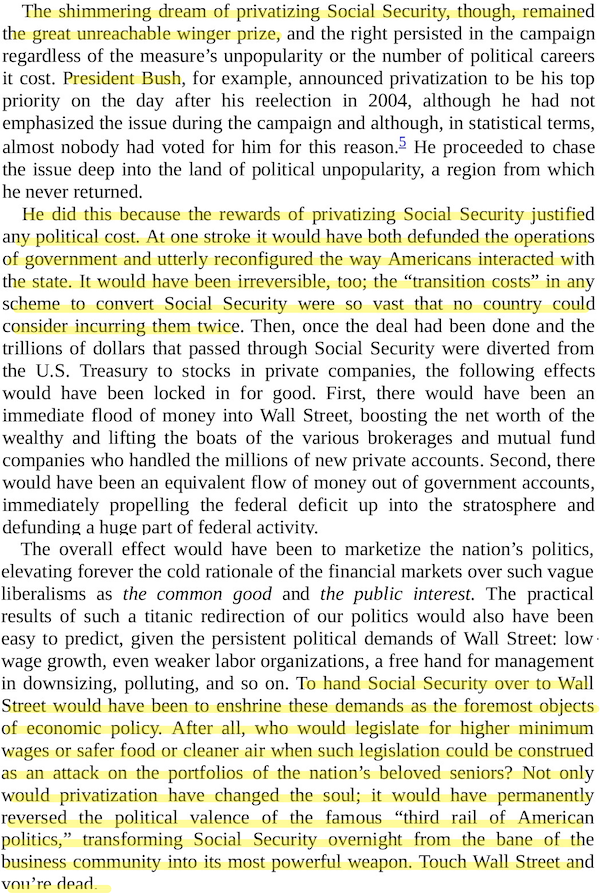
Of course Co-Presidents Trump and Musk will attack Social Security; the gains are too great for them not to. That does not, however, mean they will succeed.
Page 244:
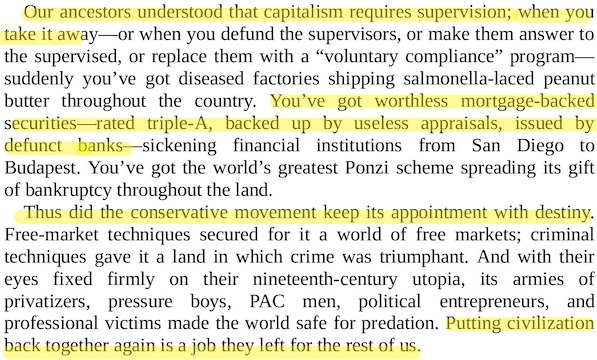
The book ends in 2008 with the conservative dreams collapsing after the Great Financial Crash. Frank writes: “Putting civilization back together again is a job [conservatives] left for the rest of us.” And we elected Obama to do it. So it goes.
The purpose of this very superficial canter through the history of conservatism — not Frank’s book, which is great, but my extracts — is to remind readers, again, that “we’ve been here before.” Those readers who were not blogging in 2003 – 2006 may find what Trump is doing new or innovative. However, as reading Frank shows, almost everything about Trumpism (at least for domestic policy) is neither, which implies to me that — for good or ill — the Triumph of Trumpism is not inevitable or pre-ordained. Some may find that re-assuring.
Reading Frank’s detailed retellings of scandals and battles past, it seems to me that the difference between the previous conservative eruptions — Reagan, Bush the Younger — and Trumpism is at least three-fold: (1) the open, daily involvement of an oligarch (Musk) in governance; (2) the feral qualities of DOGE (the Executive Orders, the Bolshevik-style capture of OPM and Treasury payment services, the firings); (3) the general administration attitude that “it is better to ask for forgiveness than permission” with regard to the law and precedent (it’s as if the entire Nixon administration was run by Howard Phillips). Each of these characteristics holds open the possibility of significant pushback, especially for an administration running on thin margins everywhere (House, Senate, polling).
I have characterized Trumpism as reactionary, as indeed it is (reactive not only to policies like DEI, to PMC hegemony generally, but retributive justice for the destruction of the Rust Belt, undertaken by many distinctly non-MAGA forces in years past). To me, the value of Trumpism is the reaction to its reaction. The Democrat leadership, so far, has reacted as if all they have to do is wait until the midterms and flip a few seats (much as all they had to do was wait for demography to save them during the heyday of Tiexiera’s “coalition of the ascendant”). Then maybe they can run near-winner Kamala again, or a greatly matured and near-gravitas-possessed Pete.
The reaction by Democrat leadership to Trump’s Thirty Four Days has seemed insufficient even to their PMC loyalists, who are, naturally, concerned with more pressing matters than the midterms: Their jobs are at stake (along with their houses, and violin lessons for little Madison, not to mention all that karma for the Rust Belt their capital, economic, social, and symbolic). Whether their demand for reaction now creates space for new leadership now is an open question (even though there’s no question that the Democrats need new leadership desperately, and that down to the precinct level). Of course, other reactions might take place: The formation of a labor party, akin to the Republicans of 1854 in its ability to address class/ownership issues that neither existing party can address, would be intriguing, especially if the unions could move up that (hypothetical?) general strike from 2028 to an earlier date. The future lies ahead!






